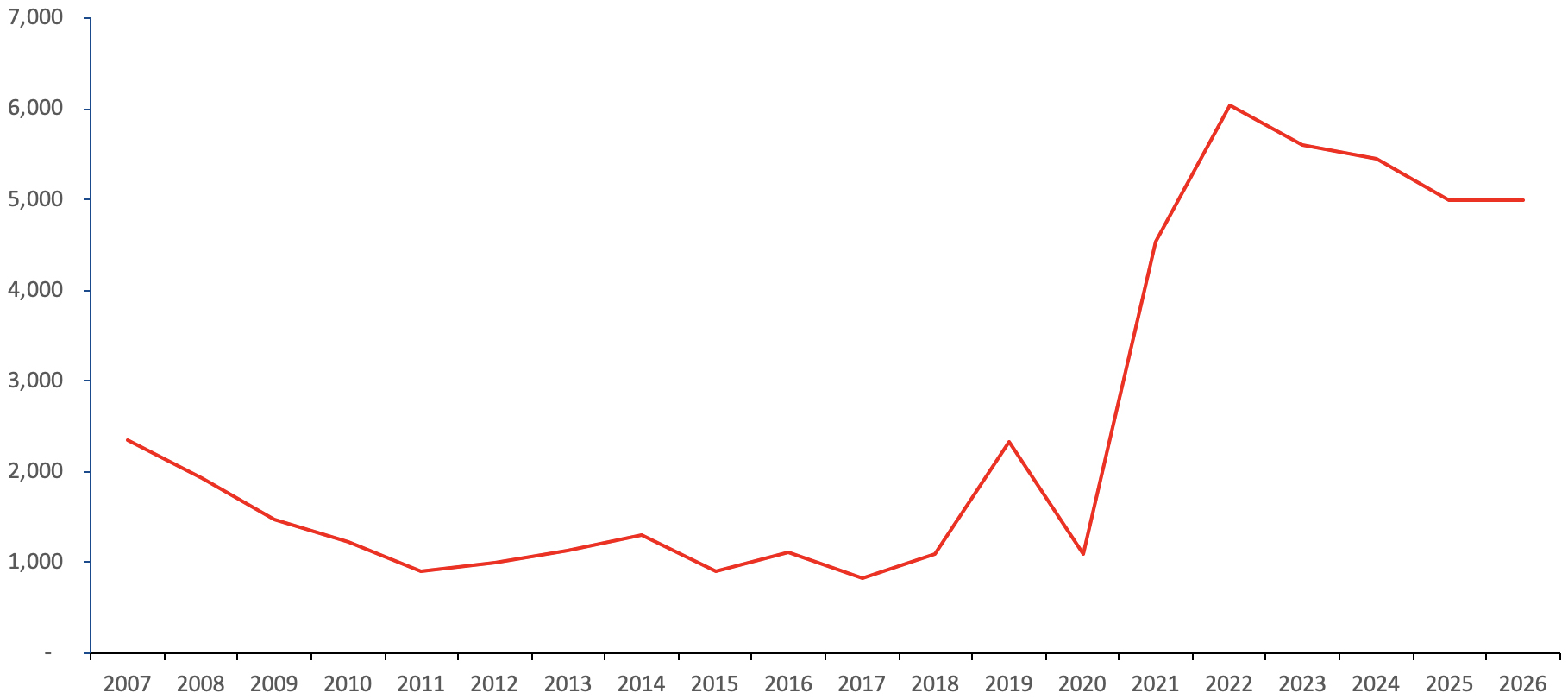Why Would the Senate Consider a Bill Codifying a Decline in Border Security?
As you’ve likely heard, a now-defeated bipartisan (tri-partisan?) border proposal drafted by Sens. James Lankford (R-Okla.), Chris Murphy (D-Conn.), and Kyrsten Sinema (I-Ariz.) included an “emergency” authority that would have allowed the president to expel illegal migrants once CBP Southwest border encounters reach 4,000 per day, and mandate expulsions when encounters reach 8,500 per day or there is a seven-day average of 5,000 encounters. I’ll skip the loopholes and sunsets — each of which undermines that authority — and focus instead on how that “5,000 a day” rule would have conceded defeat at the border, and codified a decline in security there.
Border History. Border Patrol keeps numbers on the overall number of aliens agents have encountered at the nation’s combined borders per fiscal year going back to the formation of the component in FY 1925 (when agents apprehended just over 22,000 illegal entrants), and for the Southwest border dating to the Eisenhower administration in FY 1960 (when there were approximately 21,000 Border Patrol encounters at the U.S.-Mexico line).
Southwest border apprehensions hit their pre-Biden peak in FY 2000, as agents apprehended more than 1.643 million aliens who entered illegally — nearly all single adult males from Mexico. Then, the terrorist attacks of September 11, 2001, changed everything — at least for nearly two decades.
None of the 19 hijackers that day entered the United States illegally (all came legally, albeit fraudulently, on nonimmigrant visas), but Congress quickly recognized that unfettered immigration posed a national-security threat. Accordingly, it beefed up Border Patrol staffing and enforcement.
The number of agents on the Southwest border rose from fewer than 9,150 in FY 2001 to more than 13,000 by FY 2007, eventually hitting a peak of 18,610 in FY 2013. And, not surprisingly, the number of migrants attempting to enter illegally plummeted.
Figure 1 shows the average daily number of aliens apprehended at the Southwest border between FY 2007 and FY 2024, by fiscal year, through the end of December 2023:
As you can see, average daily apprehensions in the 14-year period prior to Joe Biden taking office topped 2,350 only once, at the beginning of that period in FY 2007. They neared that record in FY 2019, when an average of 2,333 aliens were apprehended entering illegally per day, but President Trump responded to that surge by implementing the Migrant Protection Protocols (MPP), better known as “Remain in Mexico”.
The 2019 Border Surge and “Remain in Mexico”. MPP allowed agents to return aliens apprehended entering illegally back across the border to await the removal hearings at which they would make their asylum claims. To understand the effectiveness of Remain in Mexico, here’s what apprehensions looked like, on a daily average per month, in FY 2019:
Figure 2. FY 2019 Average Daily Southwest Border Patrol Apprehensions, by Month |
| Source: “Southwest Border Migration FY 2019”, U.S. Border Patrol, undated; “Nationwide Encounters”, U.S. Customs and Border Protection, November 15, 2019. |
During that 12-month period, average daily Southwest border apprehensions exceeded 4,000 exactly once, in May 2019, as agents apprehended more than 144,000 illegal entrants for an average of roughly 4,650 apprehensions per day. By September, however — just four months later — they fell to just over 1,750 per day and kept falling, even before Title 42 was implemented in March 2020.
As an October 2019 DHS assessment of Remain in Mexico concluded, that program drove that decline, as “aliens without meritorious [asylum] claims — which no longer constitute[d] a free ticket into the United States — [were] beginning to voluntarily return home”.
Then-DHS Secretary Kirstjen Nielsen formally announced the implementation of MPP in late January 2019, but early challenges led to a brief injunction of the program that April. As security at the U.S.-Mexico line worsened in the early spring that year, Nielsen declared a March “border emergency”, explaining:
Today I report to the American people that we face a cascading crisis at our southern border. The system is in freefall. DHS is doing everything possible to respond to a growing humanitarian catastrophe while also securing our borders, but we have reached peak capacity and are now forced to pull from other missions to respond to the emergency.
In part due to that injunction, it wasn’t until July 2019 that MPP was expanded from its pilot sites in San Ysidro and Calexico (both in California) and El Paso, Texas, to Laredo and Brownsville (both in Texas), and then in late fall 2019 to Nogales, Ariz. Of the more than 39,000 aliens returned to Mexico under the program in FY 2019, nearly 27,000 were sent back between July and September of that year.
That’s why the FY 2019 figure has a sharp peak in May, and a steady decline in the months that followed.
Biden Reverses the Trump Border Policies. Joe Biden quickly “suspended” Remain in Mexico (DHS Secretary Alejandro Mayorkas later ended the policy — twice) and terminated nearly all the other the Trump-era policies that had driven illegal entries down.
The only deterrent that remained was Title 42, but instead of detaining the illegal migrants encountered at the Southwest border who were not expelled under those public-health orders (as the law requires), Biden released (by my estimation) at least 88.5 percent of them, some 3.3 million aliens in total according to a recently passed House resolution.
The administration continues to argue that the subsequent migrant surge is being driven by “hemispheric conditions” such as “food insecurity” and “climate change”.
But, as federal Judge Kent Wetherell held last March, while such “geopolitical factors” have plainly contributed to the surge, administration officials’ contentions “that the crisis at the border is not largely of their own making because of their more lenient detention policies is divorced from reality”. (Emphasis added.)
Of course, even expulsion under Title 42 is no longer a deterrent to illegal entry (those orders expired in May), which explains why Border Patrol apprehensions at the Southwest border have jumped from a daily average of just over 5,600 in FY 2023 to nearly 6,850 in the first three months of FY 2024.
The Impact of the Senate Bill. Here’s (more or less) what average daily Border Patrol apprehensions would look like if the Senate bill — and its 5,000 per-day encounter limit — had gone into effect today:
Figure 3. Average Daily Southwest Border Patrol Apprehensions, by Fiscal Year |
 |
Plainly, that would be marginally better than the current situation and an improvement over the administration’s border performance, but it would be exponentially worse than what agents at the Southwest border were dealing with just four years ago.
When Nielsen declared that border emergency, in March 2019, agents were faced with an average of 3,346 aliens per day entering illegally over the Southwest border. If that was “peak capacity”, how would you describe the difficulties they’d have dealing with an average of 5,000 illegal entrants — a roughly 50 percent increase — per day? What exactly comes after “freefall”?
5,000 Migrants Per Day and the 21 Cent Increase in an Ounce of Gold. Shortly after President Franklin D. Roosevelt took office in 1933, in the depths of the Great Depression, Congress gave the new president the power to seize privately held gold supplies.
Here’s how the Mackinac Center describes what happened next: “One morning, as Roosevelt ate eggs in bed, he and Secretary of the Treasury Henry Morgenthau decided to change the ratio between gold and paper dollars. After weighing his options, Roosevelt settled on a 21[-]cent price hike”.
Why 21 cents? FDR thought that that was a “lucky number”, and Mackinac reports that Morgenthau later wrote in his diary: “If anybody ever knew how we really set the gold price through a combination of lucky numbers, I think they would be frightened.”
I’m reminded of that bedside breakfast as I mull the 5,000 migrant per-day limit that the Senate bill set as the trigger for additional border expulsions. Perhaps some serious thought went into that figure, but more likely it was just a nice round number that seemed to make sense, given the disaster that has transpired at the Southwest border since Biden took office.
Any objective observer would have to agree that border security is worse under Biden than under any other previous administration. Instead of 5,000, perhaps the negotiators could have settled on 1,354, the average number of daily apprehensions in the 13-year period between FY 2007 and FY 2019, or even 2,000, roughly the average for the period FY 2007 to FY 2023 (it’s actually 1,988 per day).
The only thing the 5,000 per-day trigger in the Senate bill would have done is to accept the dismal status quo at the Southwest border as the new standard, forever, or at least until Congress is forced to act again. But a border that’s 50 percent worse than a “system in freefall” shouldn’t be acceptable to anyone.





